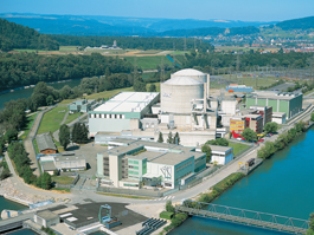Nuclear development may be put on hold in Switzerland after a cabinet decision not to allow replacement of existing reactors. If the policy gets through parliament, the last nuclear energy could be generated in the mid-2030s.
 |
| Beznau |
This came despite a February referendum that supported replacement reactors, and a report this month from Switzerland's Federal Nuclear Safety Inspectorate (ENSI) that found no immediate danger for Swiss nuclear plants in light of the Fukushima accident. Being landlocked, Switzerland is notably isolated from tsunami risk, and Swiss nuclear operators were instead warned to prepare for the failure of nearby hydroelectric dams.
On 23 March reports were ordered from the Federal Department of the Environment, Transport, Energy and Communications on three future scenarios: The early replacement of older nuclear plants to ensure safety; the non-replacement of current plants; and the early decommissioning of current units. Today the cabinet chose the second option, aiming for the end of nuclear power generation in 2034, based on 50-year operating lives for the country's five reactors.
The move would be a total reversal of a 2007 energy policy that not only focused on nuclear, energy efficiency and renewable sources but also called for the operating nuclear units to be replaced in due course with new ones. The country is anticipating an annual energy shortfall of 25-30 billion kWh by 2035 - around half the country's current generation - thanks to rising consumption and the retirement of older power plants.
Nevertheless, the cabinet said today that this "gradual abandonment is technically possible and bearable from an economic point of view" and proposed to replace the 40% of electricity that comes from nuclear with a program of energy efficiency, the expansion of hydro from its current 56% of supply and more fossil fuels "if necessary." To carry out this restructuring would cost about 0.4-0.7% of the country's gross domestic product, said the cabinet - about $1.28-2.25 billion.
The ambitous new policy remains to be submitted to parliament for approval. "After the summer session, this strategy will be reworked in light of parliamentary decisions."
Given operating lifespans of 50 years, the first Swiss reactor to shut could be Beznau 1 in 2019, followed by Beznau 2 in 2021. Taken together these smaller units would remove only 730 MWe from supply. Another 372 would be lost with the shutdown of Mühleberg around 2022. The largest units are Gösgen with 985 MWe and Leibstadt with 1165 MWe, which would likely close in 2029 and 2034 respectively. Swiss utilities have been planning in recent years to build replacements for Beznau and Mühleberg as well as a new unit at Niederamt.
Industry reaction
The utility Axpo said it 'deplores this fast, high-pressure political decision' not based on 'carefully clarified, substantiated facts' such as could come from participating the European Commission's stress tests. Furthermore, it would lead to energy security problems as well as 'massive state intervention and high costs for citizens.' Switzerland's largest utility, Alpiq, said it has 'taken note' of the cabinet decision as the start of a process of policy debate that would last several years and involve several referendums. It said it "the main focus must be on energy security" and that "until voters have had their say on the future of nuclear power - which is unlikely for several years - it will no longer drive forward plans to build new nuclear power stations."
|
Researched and written
by World Nuclear News





_91467.jpg)
_47120.jpg)
_16439.jpg)





